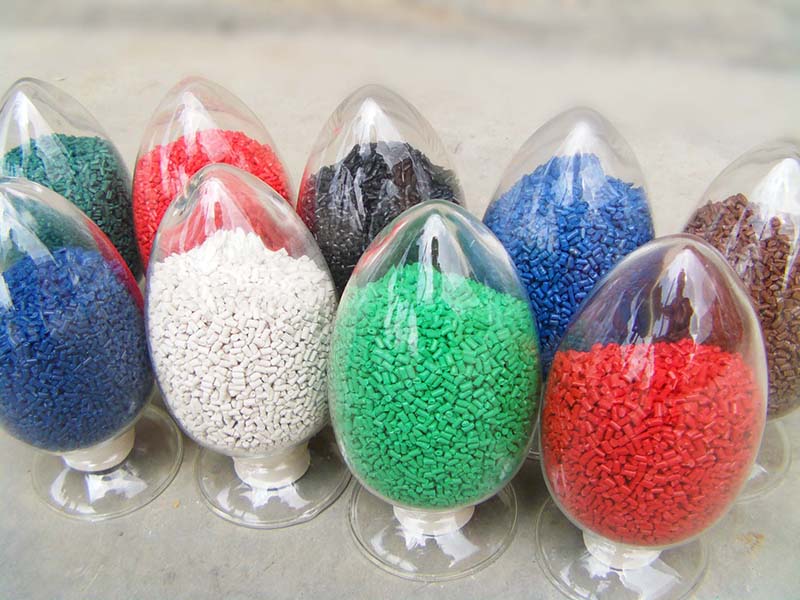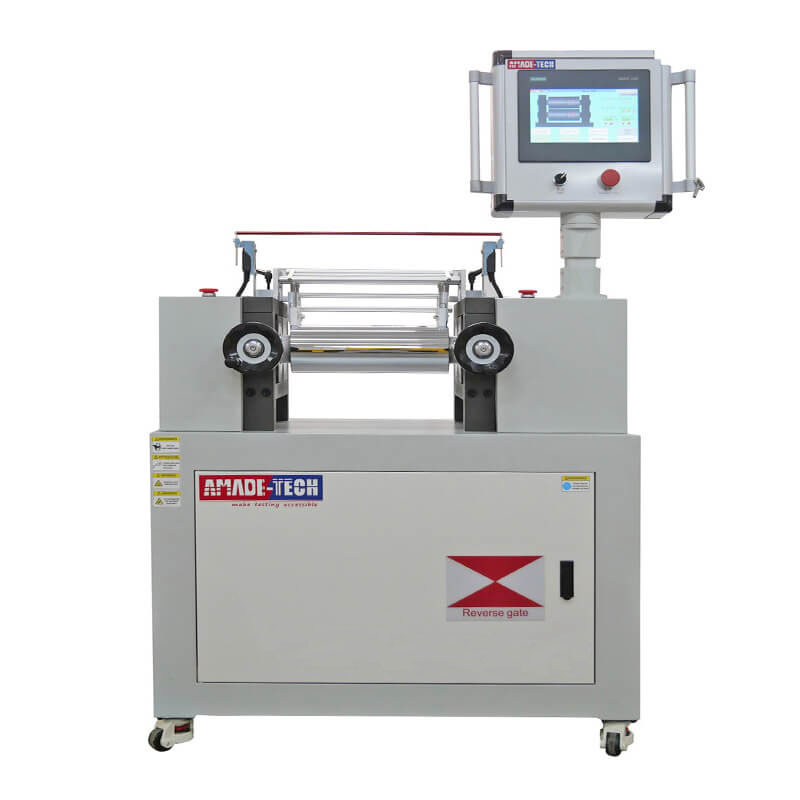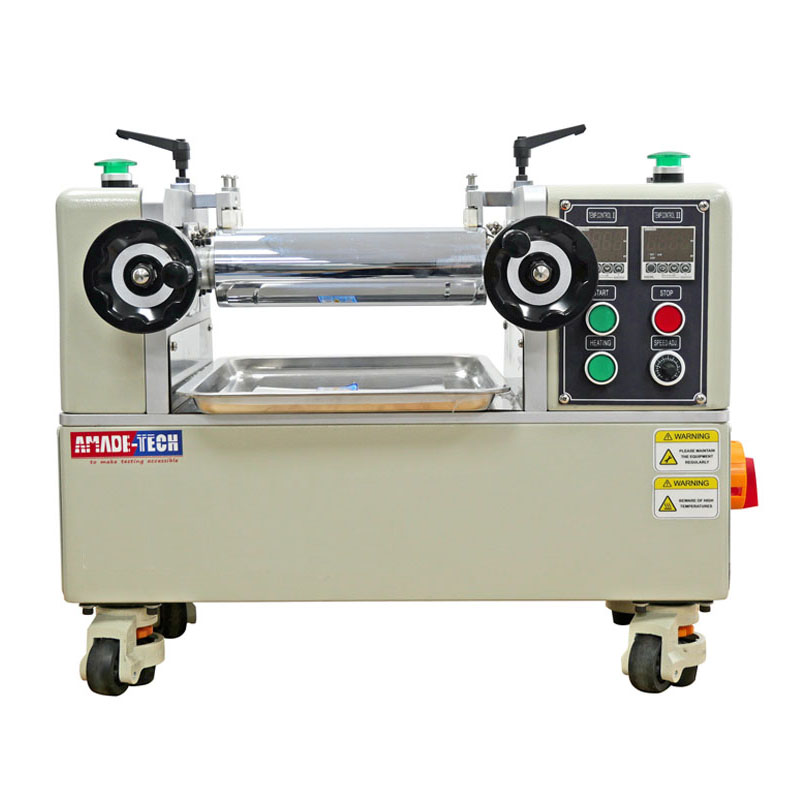What’s an Lab Two Roll Open Mixing Mill?
The lab two roll open mixing mill is a small laboratory-specific equipment used to process or prepare rubber or plastic mixtures. It is similar to the structure of the industrial production mill, but is smaller in size and can usually only process a small amount of compound at a time. The laboratory open mill is mainly used in the rubber and plastics industry. It is one of the earliest basic equipment used in laboratory rubber product processing, mainly used for rubber mastication, mixing, hot processing, sheeting, etc. In the plastics industry, the laboratory two roll mill is used to mix and plasticize plastic materials to improve their dispersion and plasticity, and to make plastic sheets to complete subsequent tests and comparisons, etc.
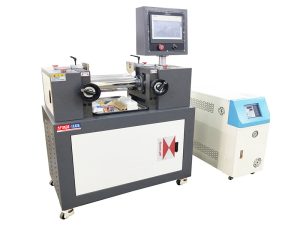
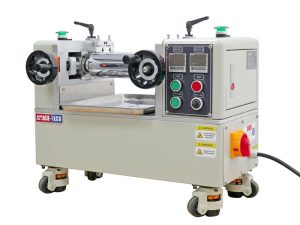
How Does a Lab Two Roll Open Mixing Mill Work?
The lab two roll open mixing mill has two horizontally arranged rolls that can rotate in opposite directions towards each other at different speeds. When the material is fed to the upper area between the two rolls, it is pulled between the two rolls due to the friction and adhesion between the material and the roller surface, as well as the bonding between the material components. The material is then subjected to strong shearing and squeezing to become a sheet and wrapped around one of the rolls. As the rollers rotate, the material returns to the area between the two rollers. After repeated shearing and squeezing, the material softens and forms a plasticized state, and finally the goal of evenly mixing the components is achieved. Before mixing the plastic material, the rolls need to be heated to a specified temperature in advance. Most of the time, heating is not required when processing rubber materials. Instead, cooling water is needed to cool the material during the operation when necessary.
What Are Key Considerations and Features When Choosing a Right Lab Two Roll Open Mixing Mill
1. Roll Material
The rolls are the most important working parts of the Lab two roll open mixing mill, and they are the part directly involved in material processing. The basic requirement for the roll of the mixing mill is to have sufficient mechanical strength and rigidity to ensure that the roll is not damaged during normal use. In addition, the roll requires good thermal conductivity to facilitate heating and cooling of the material. Generally, for rolls without heating function, they are generally made of chilled cast iron. Its characteristics are hard surface layer, good internal toughness, high strength, good wear resistance and corrosion resistance, easy manufacturing and low cost. However, one disadvantage of chilled cast iron is poor internal machinability. When we need to install heating devices inside the roll, we generally need to choose high carbon steel or alloy steel as the material of the roll.
2. Roll Surface Treatment
The surface of the two roll open mill roll should have high hardness, wear resistance, chemical corrosion resistance to avoid being damaged by the scraper or corroded by certain compounding agents during mixing. We usually plate a thick layer of hard chrome on the surface of the roll to achieve and strengthen these characteristics, and it is convenient for cleaning and maintenance of the roll. The surface of ordinary chrome-plated rolls is neither very rough nor very smooth. In view of different processing materials, we will recommend different roll surface treatment processes to facilitate processing operations. If you use an lab two roll mill to masticate or mix rubber materials, we will recommend that the machine be equipped with a pair of matte rolls. The surface of the matte roll is sandblasted to form a certain degree of roughness and present a matte effect. When processing rubber, the advantage of the matte roll is that it can prevent the material from slipping and improve work efficiency. If you use an mixing mill to plasticize and mix resin materials, we will recommend a pair of mirror rolls. The surface of the mirror roll is polished multiple times to achieve a bright and smooth mirror-like effect. The advantage of the mirror roll is that the material does not stick to the roll surface when processing hot-melt plastics, and the material is easy to peel off, which is convenient to produce sheets, and it is easy to clean. If you are not sure which roll surface treatment to choose, please contact us.
3. Roll Size
The mixing mill roll size includes the diameter and length of the roll. Our regular specifications include 120 mm x 350 mm, 160 x 350 mm, 200 x 520 mm, etc. The larger the size, the larger the mixing capacity per time, which means more materials that can be processed. Of course, the larger the roll size, the higher the price of the entire machine. You need to choose the most cost-effective machine based on the amount of mixing you want per time. The capacity formula for one-time mixing is as follows:
- q=KDL
- Where
- q is the mixing capacity per time
- D is the roll diameter
- L is the length of the working part of the roll
- K is the empirical coefficient, generally K= 0.0065 ~ 0.0085
4. Roll Heating and Cooling
When mixing and plasticizing thermoplastic particles, the roll surface temperature must be raised to a high temperature required in advance to preheat the material. This requires the rolls to be equipped with a heating function, otherwise the operation cannot be carried out. The most commonly used heating method for our two roll mill is electric heating. Of course, if necessary, we can also provide open mills with steam heating and oil heating rolls.
According to the requirements of rubber processing technology, the surface of the lab two roll open mixing mill roll should maintain a certain temperature to ensure good rubber mixing effect, high quality and short time. For example, when natural rubber is plasticized, in order to ensure good mechanical action, the temperature should be controlled at about 50 to 60 degrees Celsius. When it exceeds 70 degrees Celsius, the plasticizing effect will be greatly reduced. During mixing, it is generally not more than 75 to 90 degrees Celsius to prevent the rubber from vulcanizing early. In order to ensure these temperature conditions, we must equip the rolls of the open mill with a cooling water channels to cool the material when necessary. Except for a few special synthetic rubbers, most rubber mixing mills do not require heating functions.
5. Roll Speed
Roll speed refers to the linear speed of the roll when it is working. This speed is proportional to the shear force on the material. You can choose a machine with a fixed roll speed or a machine with adjustable speed. The general roll speed range is 0 ~ 30 rpm. Generally, the roll speed does not need to be adjusted when processing rubber, but if you want to produce plastic sheets, it is best to choose a machine with adjustable roll speed for easy control and operation.
6. Roll Friction Ratio
The linear speeds of the two roll surfaces are different. The speed ratio refers to the ratio of the linear speeds of the two rolls. The larger the friction ratio, the stronger the shearing and squeezing effect of the rolls on the material, which can reduce processing time and improve mechanical effects. However, when the friction ratio is too large, the frictional heat will increase the material temperature, resulting in reduced plasticizing effect of the raw rubber or causing scorching during mixing. So you need to choose a suitable friction ratio according to your processing needs. Alternatively, you can choose a dual frequency adjustable friction ratio model, which allows you to freely adjust the speed of the front and rear rolls separately as needed. Different materials will get different speed requirements for the front and rear rolls. For rubber mixing, the front roll speed should be less than the rear roll speed, but when used for plastic mixing, the front roll speed should be greater than the rear roll speed because plastic materials tend to wrap around the fast roll, which is convenient for operation.
7. Motor power
The motor power is also a point to consider when buying a lab two roll open Mixing mill. Too low power makes it difficult to drive the rolls to process materials, which reduces work efficiency and, more seriously, shortens the life of the machine. Too high power will lead to excess power, extra energy consumption, and increase procurement costs. Generally, for open mills used to process rubber, we will configure a high-power motor(s) for you, because rubber materials generally have high viscosity and are not easy to disperse. If it is a machine used to mix plastic materials, we will configure a relatively small power motor for you, which can meet the use requirements.
Why do You Need a Lab Two Roll Open Mixing Mill?
1. Small-scale Production
Laboratory mixing mills generally have smaller rolls, which means that they only need a small amount of raw materials to process them into the desired state of compound each time. When doing polymer formulation development and testing, you may need to prepare and process samples repeatedly. If only a small amount of raw materials is needed for each operation, lab mixing mill will eventually help you save materials and costs and avoid waste.
2. Accurate Mixing Control
Laboratory two roll mills allow you to accurately add the required dosage of ingredients at each stage of experiment, and achieve precise control and grasp of the raw material composition of the mixture, thereby greatly improving the accuracy of formula development. This lab roll mill is very suitable for preparing high-quality, high-precision rubber or plastic mixtures and the development of various formulations.
3. Lightweight Design
Compared to production-type open mills, laboratory mixing mills are much smaller in size and weight. It does not need to occupy too much space. And we have installed casters on the equipment, allowing you to push it around the workplace and easily move it from one room to another, so it is very suitable for use in the laboratory. For desktop open mills, you can put it on the table to process materials.
4. Flexible Configuration
The various configurations of the laboratory mixing mill can be customized according to your needs, including roll size, roll friction ratio, roll speed, etc. In addition, you can choose to add or reduce certain functions. Flexible configuration can achieve a perfect match between machine functions and processing needs, which not only improves processing efficiency but also saves procurement costs for you.
5. Automatic Control
If necessary, the laboratory mixing mill can be equipped with an automatic material turning device: that is, the material attached to the front roll is automatically turned back and forth by a scraper when the machine is running. Compared with the traditional manual operation to cut and fold the material, the automatic material turning system turns the material more evenly, freeing up both hands to save physical strength and improve safety.
Where to Get a Quality Lab Two Roll Open Mixing Mill That Matches Your Test Project?
Welcome to AmadeTech where professionalism meets unparalleled expertise in laboratory equipment! At AmadeTech, we are dedicated to providing top-of-the-line lab two roll mixing mills that exceed industry standards. Our team of experienced professionals ensures that each product is meticulously crafted to precision, guaranteeing reliable and accurate results for your lab applications. In addition to the conventional configuration, we can also bring you a high-end experience, such as an automatic scraping device that frees your hands, a one-button pop-up device for the roll for improving safety , and an oil heating device that ensures a more uniform roll temperature and faster heating and cooling. Trust in AmadeTech for all your lab equipment needs, and experience the difference that true professionalism can make in optimizing your research and production processes.






